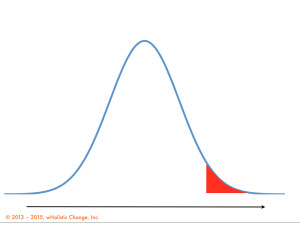A few years ago my husband shared Clay Shirky’s A Rant About Women with me. While I bristled at first, I have to admit that we as women need to get better at self-promotion. We need to get more comfortable telling people what we do, and, specifically, what we do well.
I’m going to start by talking about cleaning the bathroom. Now, before you turn back to your smartphone or leave this site to watch cute kitten videos on YouTube, I want to tell you why cleaning the bathroom is important.

My sophomore year in college, I moved out of the dorm and into an apartment with 4 other girls. Yes, it was a 3-bedroom apartment (a 3rd floor walk-up, as my parents who helped me haul heavy furniture up 3 levels of spiraling staircase will attest) for 5 of us, with 1 bathroom. One of the first things we did as roommates was to create a list of chores and a cleaning schedule.
As an undergraduate I majored in molecular biology and therefore took multiple classes each semester with long lab hours. I was poor, paying my way through school. The same year I moved off-campus, I also got a work/study job in a molecular biology lab at the university. My job was not glamorous; I washed the dishes. In molecular biology, scientists work on such a small scale that it is critical that their equipment be immaculate. There was a whole procedure that involved soap, specialized brushes, multiple rinse cycles, and a final rinse with purified water. There were 2 of us work/study students in this lab: me and a guy from my major. One of the graduate students taught us how to wash the glassware, and then we each got keys to the lab. The professor and researchers didn’t care when we came in to wash the dishes, just so they had clean glassware for their experiments during the day.
I was a very active college student: I was involved in student government, I participated in numerous honor societies, and I also volunteered as a tutor at local middle schools. Plus I had to maintain a high grade point average to qualify for scholarships and to prepare for where I really wanted to go, graduate school. Due to my busy schedule, I left the apartment early in the morning, spent all day on campus in classes and labs, washed glassware in the evenings, and got home late at night. My turns to do apartment chores often meant I was cleaning the bathroom at midnight.
I was raised in the Midwest with the core value that we are all a part of the same community. What is important is that you pitch in and do your part. It doesn’t matter if anyone sees you do it, and you do NOT need to toot your own horn! (In actual fact, tooting your own horn is often discouraged in the Midwest.) Just never shirk your responsibilities and always pull your weight!
What I did not realize at the time was that if people don’t see you doing something, they don’t necessarily believe that you did it. The year I moved off-campus, I experienced this lesson twice.
First, my roommates held a meeting one afternoon and were all waiting for me in the living room when I got home that night. They wanted to talk to me about the fact that they had not seen me clean the bathroom, and didn’t I understand that that was one of my roles as a member of the household? I explained that I HAD cleaned the bathroom every time it was my turn. I just did it quietly at night so as not to wake anyone.
That was when I learned that I had overestimated the perceptions of female college students in the morning. I expected that whoever got up first would note the smell of bleach and Comet and think “Hey, isn’t this bathtub shiny? What a lovely way to start my day!” And thereafter tell the other roommates that I had fulfilled my chores that week. It turns out college students don’t think like this. Who knew?
Second, my fellow dishwasher was promoted to do research in the molecular biology lab where we worked. It turns out he had made a point of always washing the dishes when the graduate students (or the professor) were in the lab, and then showed an interest in what they were doing.
As an aside, this student informed me that he had also questioned where I was and whether I was pulling my weight as a dishwasher, since none of them had actually SEEN me in the lab since that first day of training. I pointed out that the dishes were being washed, and that it was not elves magically cleaning the glassware. (OK, not my finest hour, but I was young!)
All of which brings me back to my premise: just because we show up and do a good job, or do good things behind the scenes to make sure things go off without a hitch, does not mean our bosses or others in positions of power realize that we have contributed to our team’s overall success. Unless they actually SEE us clean the bathroom (or wash the dishes, or work on a presentation…) they are not going to magically promote us and assign us to something greater than where we are today. We have to become better at tooting our own horn!
Now I am not saying that we need to become egoists or narcissists who expect a pat on the back every time we simply respond to an email… and I am definitely NOT saying we should belittle anyone else to get ahead, ourselves.
What I am saying is that we need to learn to recognize our own worth, and to start helping those around us to see what we are worth, too. By learning to promote ourselves and the good work we do, in professional and appropriate ways, we will make it OK for others to learn to recognize their worth, too. And who knows, maybe we can reach a point where we won’t have to tell anyone we cleaned the bathroom–people will wake up and recognize that things are shinier than they were yesterday. And they will learn to value all those who work behind the scenes, helping to make our lives easier and maybe just a little bit cleaner!

![[lonely blue boat, stuck in the mud]](https://live.staticflickr.com/7061/6774308114_945aa46dcb_z.jpg)






